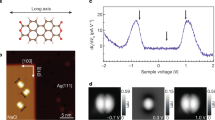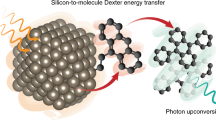Abstract
Photon absorption by carbon nanotubes creates bound electron–hole pairs called excitons1,2,3,4,5,6,7,8, which can exist in spin-polarized triplet or spin-unpolarized singlet configurations. Triplet excitons are optically inactive owing to the weak spin–orbit coupling in nanotubes. This prevents the optical injection of electron spin into nanotubes for spintronic applications9 and limits the efficiency of photocurrent generation10. Here, we show that it is possible to optically excite the triplet exciton by using a ferromagnetic semiconductor as a spin filter11 to mix the singlet and triplet excitons. The triplet contribution to the photocurrent is detected, representing the first direct evidence of the triplet exciton in carbon nanotubes.
This is a preview of subscription content, access via your institution
Access options
Subscribe to this journal
Receive 12 print issues and online access
$259.00 per year
only $21.58 per issue
Buy this article
- Purchase on Springer Link
- Instant access to full article PDF
Prices may be subject to local taxes which are calculated during checkout




Similar content being viewed by others
References
Ando, T. Excitons in carbon nanotubes. J. Phys. Soc. Jpn 66, 1066–1073 (1997).
Wang, F., Dukovic, G., Brus, L. E. & Heinz, T. F. Optical resonances in carbon nanotubes arise from excitons. Science 308, 838–841 (2005).
Maultzsch, J. et al. Exciton binding energies in carbon nanotubes from two-photon photoluminescence. Appl. Phys. Lett. 72, 241402 (2005).
Zhao, H. & Mazumdar, S. Electron–electron interaction effects on the optical excitations of semiconducting single-walled carbon nanotubes. Phys. Rev. Lett. 93, 157402 (2004).
Ando, T. Effects of valley mixing and exchange on excitons in carbon nanotubes with Aharonov–Bohm flux. J. Phys. Soc. Jpn 75, 024707 (2006).
Spataru, C. D., Ismail-Beigi, S., Benedict, L. X. & Louie, S. G. Excitonic effects and optical spectra of single-walled carbon nanotubes. Phys. Rev. Lett. 92, 077402 (2004).
Perebeinos, V., Tersoff, J. & Avouris, P. Radiative lifetime of excitons in carbon nanotubes. Nano Lett. 5, 2495–2499 (2005).
Barros, E. B. et al. Selection rules for one- and two-photon absorption by excitons in carbon nanotubes. Phys. Rev. B 73, 241406(R) (2006).
Tsukagoshi, K., Alphenaar, B. W. & Ago, H. Coherent transport of electron spin in ferromagnetically contacted carbon nanotube. Nature 401, 572–574 (1999).
Hu, X. & Hu, B. Photovoltaic processes of singlet and triplet excited states in organic solar cells. Adv. Funct. Mater. 18, 2611–2617 (2008).
Moodera, J. S., Santos, T. S. & Nagahama, T. The phenomena of spin-filter tunneling. J. Phys. Condens. Matt. 18, 1–24 (2006).
Tretiak, S. Triplet state absorption in carbon nanotubes: A TD–DFT study. Nano Lett. 7, 2201–2206 (2007).
Srivastava, A., Htoon, H., Klimov, V. I. & Kono, J. Direct observation of dark excitons in individual carbon nanotubes: Inhomogeneity in the exchange splitting. Phys. Rev. Lett. 101, 087402 (2008).
Mohite, A. D., Gopinath, P., Shah, H. M. & Alphenaar, B. W. Exciton dissociation and Stark effect in the carbon nanotube photocurrent spectrum. Nano Lett. 8, 142–146 (2008).
Mohite, A., Lin, J.-T., Sumanasekera, G. & Alphenaar, B. W. Field enhanced photocurrent spectroscopy of excitonic states in single-wall carbon nanotubes. Nano Lett. 6, 1369–1373 (2006).
Mohite, A. D. et al. Photocurrent spectroscopy of double-wall carbon nanotubes. Chem. Phys. Lett. 412, 190–194 (2005).
Mohite, A., Gopinath, P., Chakraborty, S. & Alphenaar, B. W. Displacement current detection of photoconduction in carbon nanotubes. Appl. Phys. Lett. 86, 061114 (2005).
Vaddiraju, S. et al. Mechanism of 1D crystal growth in reactive vapor transport: indium nitride nanowires. Nano Lett. 5, 1625–1631 (2005).
Mauger, A. & Godart, C. The magnetic, optical and transport properties of representatives of a class of magnetic semiconductors: the europium chalcogenides. Phys. Rep. 141, 51–176 (1986).
Dimmock, J. O. Optical properties of the europium chalcogenides. IBM J. Res. Develop. 14, 301–308 (1970).
Dukovic, G. et al. Structural dependence of excitonic optical transitions and band-gap energies in carbon nanotubes. Nano Lett. 5, 2314–2318 (2005).
Lefebvre, J. & Finnie, P. Polarized photoluminescence excitation spectroscopy of single-walled carbon nanotubes. Phys. Rev. Lett. 98, 167406 (2007).
Ajiki, H. & Ando, T. Electronic states of carbon nanotubes. J. Phys. Soc. Jpn 62, 1255–1266 (1993).
Zaric, S. et al. Excitons in carbon nanotubes with broken time-reversal symmetry. Phys. Rev. Lett. 96, 016406 (2006).
McGuire, T. R. Magnetic properties of some divalent europium compounds. J. Appl. Phys. 34, 1345–1346 (1963).
Hao, X., Moodera, J. S. & Meservey, R. A thin film superconductor in an exchange field. Phys. Rev. Lett. 67, 1342–1345 (1991).
Ohno, Y. et al. Excitonic transition energies in single walled carbon nanotubes: dependence on environmental dielectric constant. Phys. Stat. Sol. B 244, 4002–4005 (2007).
Kavarnos, G., Cole, T., Scribe, P., Dalton, J. & Turro, N. External heavy-atom induced spin–orbital coupling. Spectroscopic study of naphthonorbornanes. J. Am. Chem. Soc. 93, 1032–1034 (1971).
Romanova, Z., Deshayes, K. & Piotrowiak, P. Remote intermolecular ‘heavy-atom effect’: spin–orbit coupling across the wall of a hemicarcerand. J. Am. Chem. Soc. 123, 2444–2445 (2001).
Hu, B., Wu, Y., Zhang, Z., Dai, S. & Shen, J. Effects of ferromagnetic nanowires on singlet and triplet exciton fractions in fluorescent and phosphorescent organic semiconductors. Appl. Phys. Lett. 88, 022114 (2006).
Shao, Y. & Yang, Y. Efficient organic heterojunction photovoltaic cells based on triplet materials. Adv. Mater. 17, 2841–2844 (2005).
Freitag, M., Martin, Y., Misewich, J. A., Martel, R. & Avouris, P. H. Photoconductivity of single carbon nanotubes. Nano Lett. 3, 1067–1071 (2003).
Hoijtink, G. J. The influence of paramagnetic molecules on singlet–triplet transitions. Mol. Phys. 3, 67–70 (1960).
Murrell, J. N. The effect of paramagnetic molecules on the intensity of spin-forbidden absorption bands of aromatic molecules. Mol. Phys. 3, 319–329 (1960).
Evans, D. F. Magnetic perturbation of singlet–triplet transitions. J. Chem. Soc. 3885–3888 (1957).
Pierce, D. T. et al. GaAs spin polarized electron source. Rev. Sci. Instrum. 51, 478–499 (1980).
Acknowledgements
The authors thank S. Tretiak for theoretical guidance, and for his critical reading of this manuscript. Financial support was provided by the Office of Naval Research ONR N00014-06-1-0228 and ONR N00014-06-1-0235, the National Science Foundation NSF DMR 0504158 and the U.S. Department of Energy DE-FG02-07ER46375.
Author information
Authors and Affiliations
Contributions
B.W.A. conceived the experiment and wrote the manuscript. A.D.M. performed the device fabrication and optical characterization. T.S.S. and J.S.M. performed material deposition. B.W.A., A.D.M. and J.S.M. designed the experiment, discussed the results and commented on the manuscript.
Corresponding author
Supplementary information
Supplementary information
Supplementary information (PDF 462 kb)
Rights and permissions
About this article
Cite this article
Mohite, A., Santos, T., Moodera, J. et al. Observation of the triplet exciton in EuS-coated single-walled nanotubes. Nature Nanotech 4, 425–429 (2009). https://doi.org/10.1038/nnano.2009.122
Received:
Accepted:
Published:
Issue Date:
DOI: https://doi.org/10.1038/nnano.2009.122
This article is cited by
-
Triplet–triplet exciton dynamics in single-walled carbon nanotubes
Nature Photonics (2014)
-
Quasi-Molecular Fluorescence from Graphene Oxide
Scientific Reports (2011)



